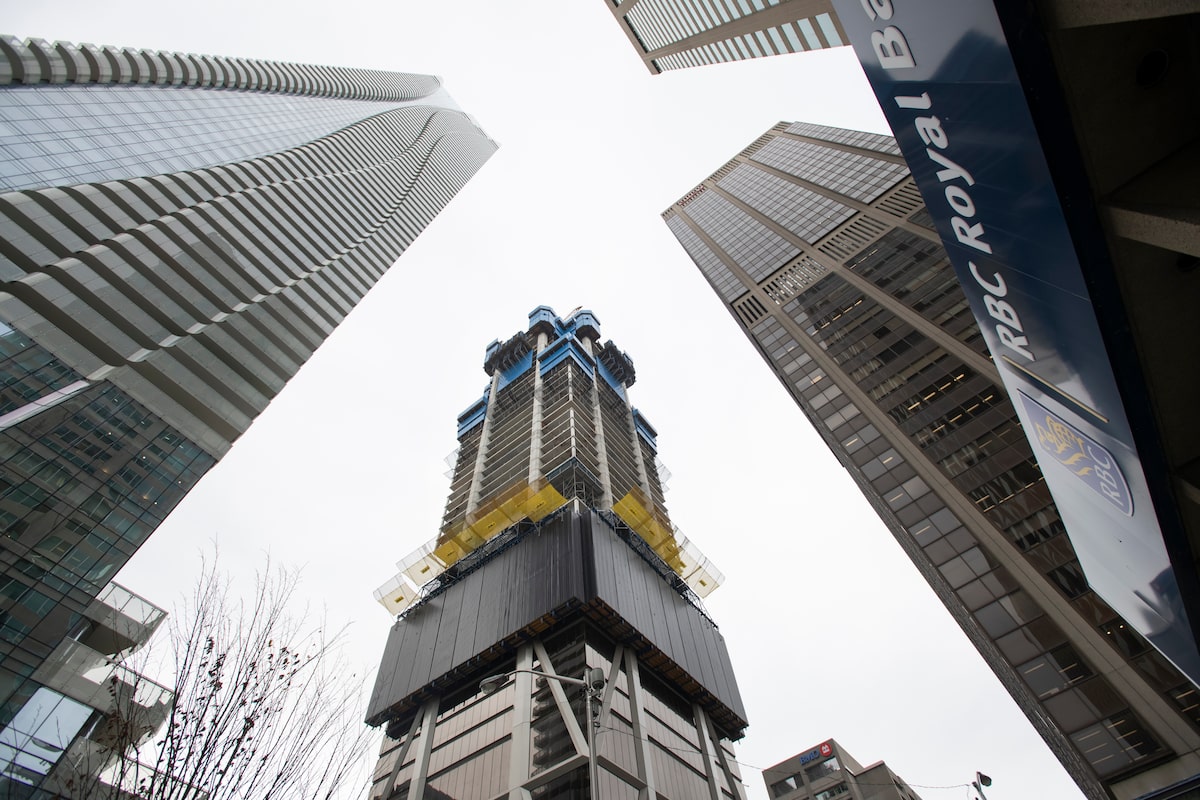The federal Liberals and Conservatives want to “solve” the housing crisis by making it easier for builders to build new units.
Sadly, with interest rates and construction prices at current levels, it seems unlikely that private companies will be able to provide the 3.5 million houses we need to restore affordability.
We need all levels of government to start building housing, not just wait for white knights from the private sector to ride in and save our middle class dreams.
Residential property developers are facing rising insolvencies as they struggle with higher borrowing and construction costs – and industry experts warn the trend is likely to worsen as interest expenses remain elevated.
…
At this pace, Canada is on track to reach about 240 real estate insolvencies this year, which would be 57-per-cent higher than 2023 and 13-per-cent higher than 2009, when a wide swath of businesses ran into problems owing to the financial crisis and global recession.
…
And that does not include the number of developers and projects that have been forced into receivership for not paying bills. The Office of the Superintendent of Bankruptcy does not include receiverships with its publicly available bankruptcy statistics. However, insolvency experts say they are seeing more projects go into receivership.
So far this year, the real estate sector accounts for 55 per cent of the receiverships recorded by Insolvency Insider Canada, a website that tracks the largest insolvencies in the country. That compares to 30 per cent last year and 33 per cent in 2022.
…
Today, the cost of residential construction is 81-per-cent higher across Canada’s major cities compared to 2017 and more than double – up 107 per cent – in the Toronto region, according to Statscan data.
So there was a huge rise during the pandemic and things are going back to the way it was?
Well that should be okay as long as the country didn’t put all its eggs in the real estate basket cause and we are too smart to do that right? Right??
We have all of our eggs in that basket. Also, I went to an affordable housing conference in 2018. At that point, Canada was in crisis. Prices are much higher now
that should be okay as long as the country didn’t put all its eggs in the real estate basket cause and we are too smart to do that right? Right??
Yeeeeeeeeees…
Today, the cost of residential construction is 81-per-cent higher across Canada’s major cities compared to 2017 and more than double – up 107 per cent – in the Toronto region, according to Statscan data.
And part of that’s inflation, and the rest of it is . . . what? Higher property costs for unbuilt land? New environmental regulations? Increased municipal permitting and red tape? Companies driving the expenses up by building large detached houses no one can afford? A knock-on effect from industries producing building supplies?
Are the costs being driven up at a similar rate outside major cities?
I work at a plant that produces a common construction material. When the company heard the government wants to build more houses, the company raised our prices. I’m absolutely sure this has happened with every business that is involved in construction. When the government says they’re going to spend money buying something to make people happy, corporations jack up the price and blame “increased demand”.
That’s how supply and demand works. When the government decides to build something, they create more demand for materials but they don’t create more supply. If they could snap their fingers like a genie and create a pile of building materials out of thin air then they could make prices go down. But obviously they can’t do that!
You might say “oh well the construction materials companies could just keep charging the same prices and be satisfied with their current profits” and you’d be right, they could do that. But then the distributors and retailers would raise prices and capture those profits themselves! You could also insist that the distributors and retailers do the same thing. But then you’d get private individuals stockpiling the materials and reselling them at a profit, just like people did with toilet paper shortages during COVID.
You could then say “oh but we’ll make that illegal too” then you end up with a black market. Now you’ve got to hire tons of police officers to fight against the black market you created with your price control policies.
Ultimately you can’t win against the laws of supply and demand.
I mean there is actually increasing demand so I’m not really sure if this is an example of corporate greed or if it’s just a realistic adjustment to the market. If the government is effectively subsidizing housing starts, it’s pretty reasonable to expect that without removal of tariff barriers and trade barriers for building materials, that the price of building materials would just increase in Canada overall. The only variables that Canada can really control is the price of softwood lumber due to the prevalence of stumpage fees, and the cost of importing foreign skilled trades labour (which is vehemently opposed by trade unions in Canada.) I can only hope that your plant is reinvesting its profits into increasing supply instead of paying out dividends, which would improve the ability to facilitate housing starts in the long run.
It’s due to capitalism, when the driver is maximize profit, why would one lower prices after “the market” pushed it higher?
It is a result of line goes up policies. Everything must always get more valuable. Profits must always increase. Budgets must be spent to get more next year.
Thing is, there’s still what you might call a stagnation space between “line goes up” and “must declare bankruptcy”, one in which even a publically traded company can ride for a year or so without the shareholders getting too anxious while they wait for the line to start going up again. Yes, you’ll get the occasional company cratering by doubling down on a bad decision made in pursuit of line-goes-up, but 240 of them suggests that there’s something more going on here.
It may be that the issue is the “higher borrowing costs” that the article alludes to, and the way these companies have been conditioned to do business causes them to overextend themselves by borrowing too much. That means that the ones that stay afloat will be the ones that can correctly balance the risks inherent in taking out loans.
Lol.
There is zero chance that anyone is going to build 3.5 million units. Zero. Even 5,000 units across all of Canada won’t happen.
It would destroy the current housing market and any politician or party that tried it would be voted out immediately.
So again, lol.
I don’t think you’re wrong, but housing is a massive issue that contributes to a bunch of other problems (cost of living, drug crisis, homelessness). If governments don’t step up, the next few generations are going to have a shitty time.
There is a 55 unit apartment building and a 22 unit apartment building going up within 3KM of me. In our neighbourhood there’s 5 houses for sale, one of which has sold in the last 4 months.
While I agree things are shitty, at least in my community apartments are being built. Price/cost is another story and I’d never live in a new build because its not rent controlled.
That’s awesome! I’m glad that progress is being made. In theory, government measures meant to increase builds will start kicking in soon, so that will accelerate.
Price/cost is another story and I’d never live in a new build because its not rent controlled.
This is really important. If we don’t have units people can afford, the number of available units doesn’t really matter. The CMHC estimate of 3.5 million new units by 2030 may be one way to get there. Governments building low cost/rent units is another.
Canada’s population is expected to grow by 500~3000 people daily for the next few years.
Building 5000 units Canada wide is not going to even make a dent in the housing market much less destroy it.
Work on that reading comprehension champ.
This sounds like a correction to me
A correction would either
- lower prices. Builders failing build doesn’t seem like it would lower prices in any way.
- increase supply. Builders failing will leave supply low. Since demand is increasing (partially due to a growing population), this should cause prices to rise.
- decrease demand. There are still lots of people trying to buy, and we expect the population to grow, so builders failing will not reduce demand.
This does not appear to be a correction, it appears to be a continuation of existing problems.
This sounds like the opposite of a correction. If no one is building housing, the existing supply will become more valuable.
Supply and demand doesn’t begin to explain Canadian housing issues. If I have 10 apples that i sell $1/piece, I’m not going to start selling them at $.75/piecewhen I get 30 apples.
Scarcity and competition for a scarce resource increase the value of that resource.
If we needed apples to live, and you had 1000 people wanting to buy your apples, and only had 10 of them, you can basically set the price to the highest amount 10 of those 1000 people are willing to pay. If you suddenly have 1000 apples, their value is eventually going to go down to the lowest price one of those 1000 want to pay.
The problem is we have apple hoarders with deep pockets who are willing to pay just as much for those 1000 apples as those 10, because if they don’t prop up the price, then the value of the other 100,000 apples they’ve hoarded will all fall as well. In order to seriously affect the price, we need to produce so many apples that buying them at current prices would bankrupt the apple hoarders
You’re right, I had not considered the impact of the gorram apple hoarders. As an individual, I tend to look at things from an individual perspective.
Thanks… There’s a lot of reasons why this analogy isn’t going to last now because supply and demand is grade school economics. Check out all of the ways government is subsidizing construction of units. And how does it work when a company is selling units, but they have to have an increase in revenue quarter over quarter? They can’t suddenly sell for less. Otherwise stock price will fall and executive’s will have to take parachutes. Government doesn’t want all these companies to fail, so they prop up the prices. This thing is far too complicated for supply and demand economics. Anyone selling that has invested in real estate
Check out all of the ways government is subsidizing construction of units.
Why are they subsidizing housing? To prop up prices? Supply shortage? Probably both.
They can’t suddenly sell for less
If you mean “Less than it cost to build”, then yes, that’s true. They could certainly lower their margins, if they needed to, but there is no incentive for them to do so.
I don’t think housing prices,in general, are tightly coupled to building costs. The price tends to exceed the cost because a large part of a house’s value is subjective (location, proximity to desirables, price of other homes in the area etc.).
Government doesn’t want all these companies to fail, so they prop up the prices.
How do they prop up prices? A quick google search indicates that one way the govt. props up prices is by buying mortgage backed securities. They do this to stimulate demand:
(https://betterdwelling.com/canada-is-spending-75-of-its-forecast-deficit-to-prop-up-mortgages/)
The GoC policy will only stimulate mortgage demand and therefore apply positive pressure to inflate home prices.
Ultimately, a house is worth the most that an individual is willing to pay for it, and I can’t really see how that is not a function of supply and demand.
If people did not have to compete for housing from the same, limited pool of houses, wouldn’t the price of houses necessarily drop in response?
This thing is far too complicated for supply and demand economics.
I agree it is more complicated than “just” supply and demand, but I think it is safe to say that supply and demand play a not insignificant role.
They prop up prices in a lot of ways, the first one that comes to mind is extending the length of a mortgage. That makes housing both more affordable, but also makes the banks a lot more money.




